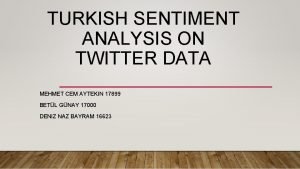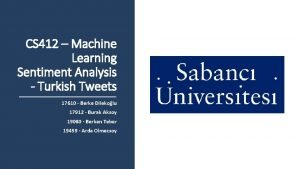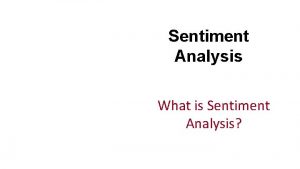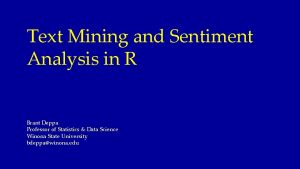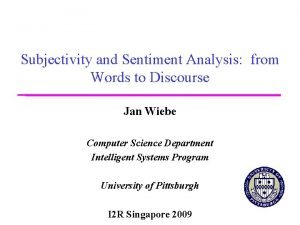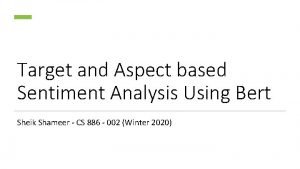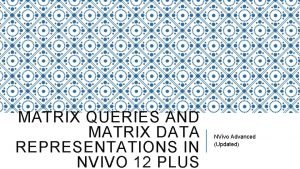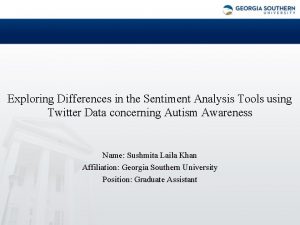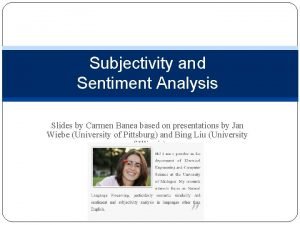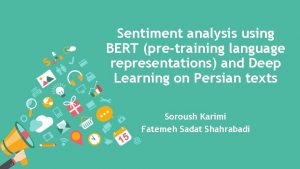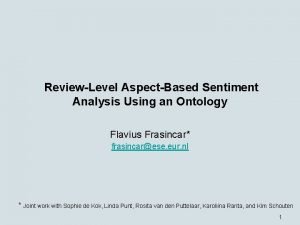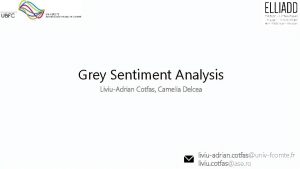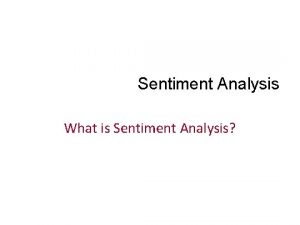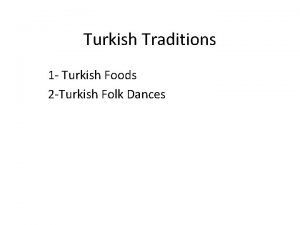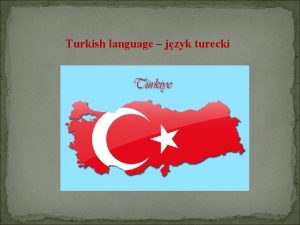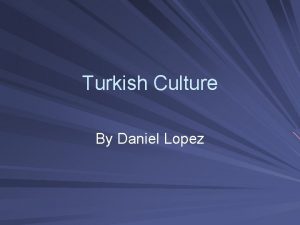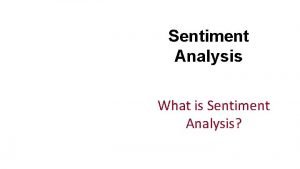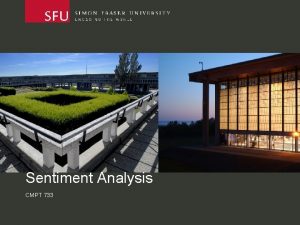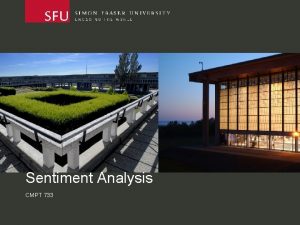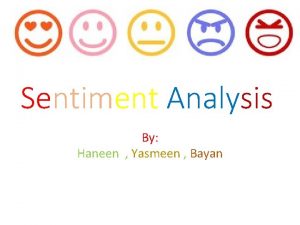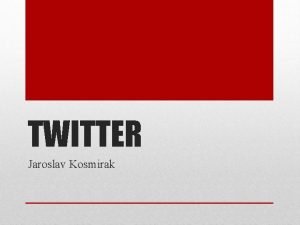TURKISH SENTIMENT ANALYSIS ON TWITTER DATA MEHMET CEM

















- Slides: 17

TURKISH SENTIMENT ANALYSIS ON TWITTER DATA MEHMET CEM AYTEKIN 17899 BETÜL GÜNAY 17000 DENIZ NAZ BAYRAM 16623

GATHERING LARGE AMOUNT OF DATA: • We made modifications on an existing project to automatize the tweet collecting process. • We gathered 1717 negative sentimental data and 687 positive sentimental data at the end. • Total of 2404 training tweets.

LABELING LARGE AMOUNT OF DATA • First we labelled them manually and then we automatized the process as follows : • For each tweet we calculated the probability of it being positive or negative based on the previous manually labelled data and if this probability is higher than a certain threshold, we made the program label the data as positive or negative automatically. • This approach can be an example of semi-supervised learning technique.

TRAINING THE CLASSIFIER • Bag of Words approach. • Constructing Vocabulary : • most common 2200 words : [('icin', 349), ('tesekkurler', 276), ('cok', 241), ('kredi', 200), ('musteri', 199) 'destek', 174), ('yok', 172), ('kart', 167), ('banka', 151), ('neden', 110), ('iyi', 102), ('daha', 97), ('bana', 97), … • Naive Bayes Classifier to train the data with the corresponding featuresets.

CONSTRUCTING FEATURE SET • Each word in the vocabulary is a feature. • Total number of features: 2200. • Each feature is boolean, meaning if that word from the vocabulary occurs corresponding feature is set True else set False. • For each tweet we look at 2200 features (words).

MOST INFORMATIVE FEATURES

CLASSIFICATION • In order to, consider this project as classification problem, we converted the regression values of tweets to labels which are positive and negative • . Tweets with regression values greater than or equal to 0 are labelled as positive and others labelled as negative. We applied the same procedure to the both given training and test data.

CLASSIFICATION RESULTS SCREENSHOTS

ACCURACY WHEN CLASSIFIER TRAINED BY OUR DATA AND SAW THE GIVEN DATA

WHICH TWEETS ARE MISCLASSIFIED ?

WHEN CLASSIFIER TRAINED WITH THE GIVEN TRAINING DATA AND SAW THE GIVEN TEST DATA

WHY IS IT THE CASE ? • Given training data consisted of 459 negative and 298 positive tweets. So the classifier only trained with 757 tweets. • However in the training set we constructed, it had trained with 2404 tweets. • More training data more accuracy.

SOME CODE SNIPPETS FROM OUR PROJECT • Note that we have only used Python and its NLTK library in the project

SOME CODE SNIPPETS FROM OUR PROJECT(1)

SOME CODE SNIPPETS FROM OUR PROJECT(2)

SOME CODE SNIPPETS FROM OUR PROJECT(3)

THANKS FOR LISTENING
 Chenghua lin
Chenghua lin Turkish sentiment analysis
Turkish sentiment analysis Turkish sentiment analysis
Turkish sentiment analysis Twitter sentiment analysis using spark streaming python
Twitter sentiment analysis using spark streaming python Azure twitter sentiment analysis
Azure twitter sentiment analysis Twitter sentiment
Twitter sentiment W62vr
W62vr Subjectivity in sentiment analysis
Subjectivity in sentiment analysis Bert aspect based sentiment analysis
Bert aspect based sentiment analysis Opinion definition
Opinion definition What is nvivo used for
What is nvivo used for Sentiment analysis tools comparison
Sentiment analysis tools comparison Moontae lee
Moontae lee Sentiment analysis for hotel reviews
Sentiment analysis for hotel reviews Slide to doc.com
Slide to doc.com Nbsvm
Nbsvm Sentiment analysis conclusion
Sentiment analysis conclusion Sentiment analysis
Sentiment analysis

